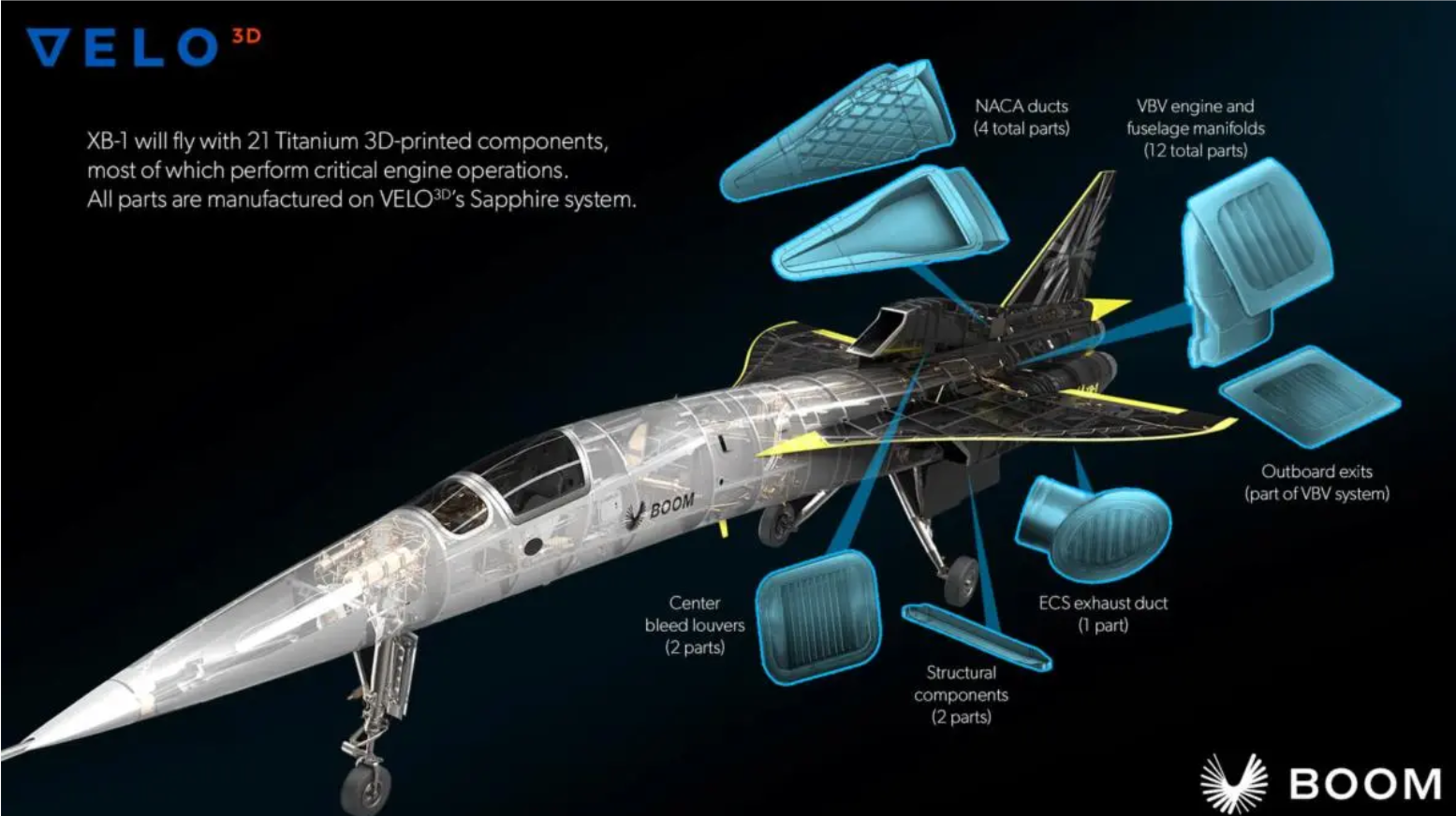October of 2020 saw the launch of aerospace firm Boom Supersonic’s XB-1 aircraft, which featured a total of 21 components 3D printed by PBF system OEM VELO3D. Now, the company has released a comprehensive case study providing a deeper dive into the design, manufacturing, and finishing of the Concorde-esque supersonic aircraft.
Citing design flexibility, weight savings, and time savings as major factors in its choice to employ additive manufacturing, Boom fabricated some of the XB-1’s most complex parts using VELO’s Sapphire 3D printer.

Design: optimizing weight and thermal efficiency
Most of the aircraft’s 3D printed parts are in some way related to channeling air, and feature complex internal geometries such as vanes, ducts, and louvres. Since the air being channeled often exceeds 260°C, a surface-based design approach was crucial.
Byron Young, an engineer at Boom, explains, “If fast moving air is touching it, we care about that surface from an efficiency and performance standpoint. So when designing these parts, you generally start with aerodynamic profiles and then trim, fillet, and thicken surfaces to create the solid part itself. The resulting parts are very complex—which meant they definitely needed to be fabricated through 3D printing.”
The company’s unique flow-directing geometries were also designed with weight savings in mind – a concept that simply wouldn’t be feasible if sheet metal or casting were to be used. As such, many of the components featured extremely thin walls, in the region of about 0.02 inches, or 750 microns.
According to Gene Miller, an application engineer at VELO, the impressive height to width ratios were made possible by the Sapphire’s non-contact recoater system: “Because our technology provides the ability to print that very high aspect ratio in this kind of design, we didn’t need excess material for strength inside the structures and we could grow those duct vanes up very high without any interference from the recoater.”

Manufacturing and post-processing
The 3D printed parts were manufactured out of titanium, an aerospace industry staple known for its high strength and temperature resistance. Unfortunately, titanium is also known to become brittle and crack-prone when cooled too rapidly. This is where the Sapphire’s advanced process control capabilities reportedly came in handy, as the machine was able to automatically check critical parameters like laser alignment, beam stability, and powder bed quality mid-build.
Miller explains, “We reduced the amount of internal stress in the substrate as the material was built up in the Z build-direction. It diminishes the possibility of cracking by mitigation of internal stresses formed during cooling.”
Once printed, the parts were sawed off the build plate and post-processed with relative ease, owing to the Sapphire’s SupportFree 3D printing technology. Small crevices and channels were completely supportless, while larger holes required minimal handwork with a screwdriver or grinder. All in all, the machinists working on the parts spent just 30 minutes on post-processing per component. The surface finishes averaged about 250 RA on a profilometer, which Boom has been happy with so far.
Finally, the components were heat treated and hot isostatic pressed to improve their fatigue lives – this is especially important for flight components as they are under constant cyclic loading with takeoff and landing.
Young concludes, “Supersonic flight introduces a number of different phenomena and stresses you generally don’t see with conventional air travel. The main forces being applied aren’t generally pressure loads from, say, breaking the sound barrier. In many cases it’s induced strain caused by the overall structure of the aircraft flexing around your part.”

Flight-critical components in the 3D printing industry
The 3D printing of flight-critical aerospace and aviation components has seen a boom in recent years, running alongside advancements in additive manufacturing technology. Aerospace company Honeywell Aerospace recently received a Federal Aviation Administration (FAA) certification for its first 3D printed flight-critical engine component. The #4/5 bearing housing is a key structural component of the ATF3-6 turbofan engine, which is featured in the Dassault Falcon 20G maritime patrol aircraft.
Elsewhere, NASA also recently announced the successful completion of 23 hot-fire tests on two of its own critical 3D printed aerospace engine components. The parts in question are a copper alloy combustion chamber and a specially developed iron-nickel superalloy nozzle.
Subscribe to the 3D Printing Industry newsletter for the latest news in additive manufacturing. You can also stay connected by following us on Twitter and liking us on Facebook.
Looking for a career in additive manufacturing? Visit 3D Printing Jobs for a selection of roles in the industry.
Featured image shows the XB-1 aircraft. Photo via Boom Supersonic.


